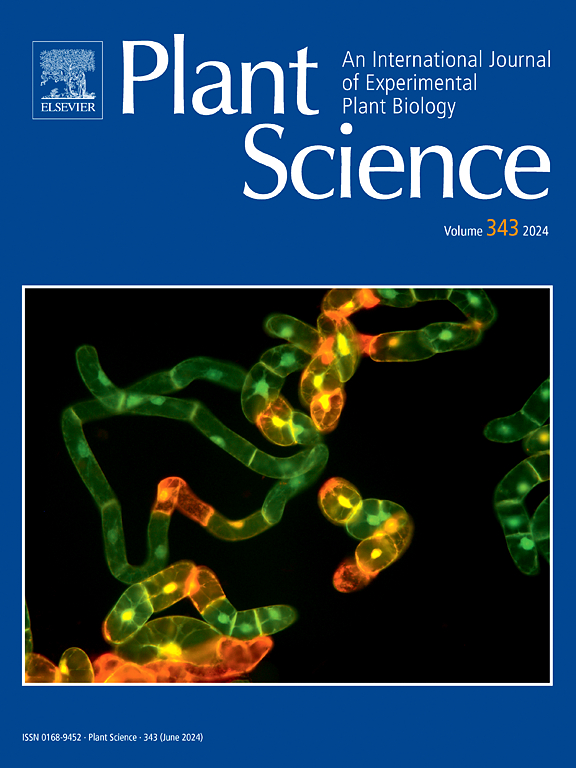一种靶向GhCNL2的新型棉花miR7814调控植物对大丽花黄萎病的防御。
IF 4.2
2区 生物学
Q2 BIOCHEMISTRY & MOLECULAR BIOLOGY
引用次数: 0
摘要
许多mirna可以转录后调节编码NBS-LRR蛋白的一类抗性(R)基因的表达水平。然而,各种mirna靶向R基因对的潜在耐药机制仍在探索中。在这里,我们研究了一种新的靶向GhCNL2功能的ghr-miR7814在植物抵抗大丽花黄萎病感染中的作用。基于GUS报告基因和5'-RLM RACE分析,ghr-miR7814通过转录后过程直接靶向GhCNL2 mRNA进行切割。通过病毒诱导的基因沉默(VIGS)或过表达实验,我们发现ghr-miR7814敲低显著提高了植物对病原菌感染的抗性,而ghr-miR7814过表达和GhCNL2敲低显著降低了植物的抗性,并伴随着防御相关基因GhPR1、GhPR3、GhPR5和GhPDF1.2的表达变化。DAB染色结果显示,敲除GhCNL2的植株中H2O2含量显著高于对照。在大丽花侵染条件下,GhCNL2敲低植株与对照植株的SA合成相关基因GhICS1、ghds1和GhPAD4的表达量及SA积累量均存在显著差异。综上所述,这些结果表明,靶向GhCNL2的新型ghr-miR7814可能通过诱导ROS和SA的生物合成来调节植物对大丽花病菌的抗性。本文章由计算机程序翻译,如有差异,请以英文原文为准。
A novel cotton miR7814 targeting GhCNL2 regulates plant defense against Verticillium dahliae infection
Many miRNAs can post-transcriptionally regulate expression levels of a type of resistant (R) genes encoding NBS-LRR proteins. However, the underlying resistant mechanisms of various miRNAs-targeted R gene pairs remain explored. Here, we addressed a novel ghr-miR7814 targeting GhCNL2 function in plant resistance against Verticillium dahliae infection. Based on GUS reporter and 5’-RLM RACE analyses, ghr-miR7814 was revealed to directedly target GhCNL2 mRNA for cleavage through post-transcriptional process. Through virus-induced gene silencing (VIGS) or overexpressing assays, we found that ghr-miR7814 knockdown significantly increased plant resistance to pathogen infection, whereas ghr-miR7814 overexpression and GhCNL2 knockdown significantly reduced plant resistance, which was accompanied by expression changes of defense-related genes including GhPR1, GhPR3, GhPR5 and GhPDF1.2. Results of DAB staining revealed that H2O2 contents in GhCNL2 knockdown plants were significantly higher than those in the control. The expression levels of SA biosynthesis-related genes including GhICS1, GhEDS1 and GhPAD4 showed significant differences between GhCNL2 knockdown and the control plants under V. dahliae infection as well as SA accumulation. Taken together, these results demonstrated that the novel ghr-miR7814 targeting GhCNL2 is able to regulate plant resistance to V. dahliae infection possibly via induction of ROS and SA biosynthesis.
求助全文
通过发布文献求助,成功后即可免费获取论文全文。
去求助
来源期刊

Plant Science
生物-生化与分子生物学
CiteScore
9.10
自引率
1.90%
发文量
322
审稿时长
33 days
期刊介绍:
Plant Science will publish in the minimum of time, research manuscripts as well as commissioned reviews and commentaries recommended by its referees in all areas of experimental plant biology with emphasis in the broad areas of genomics, proteomics, biochemistry (including enzymology), physiology, cell biology, development, genetics, functional plant breeding, systems biology and the interaction of plants with the environment.
Manuscripts for full consideration should be written concisely and essentially as a final report. The main criterion for publication is that the manuscript must contain original and significant insights that lead to a better understanding of fundamental plant biology. Papers centering on plant cell culture should be of interest to a wide audience and methods employed result in a substantial improvement over existing established techniques and approaches. Methods papers are welcome only when the technique(s) described is novel or provides a major advancement of established protocols.
 求助内容:
求助内容: 应助结果提醒方式:
应助结果提醒方式:


